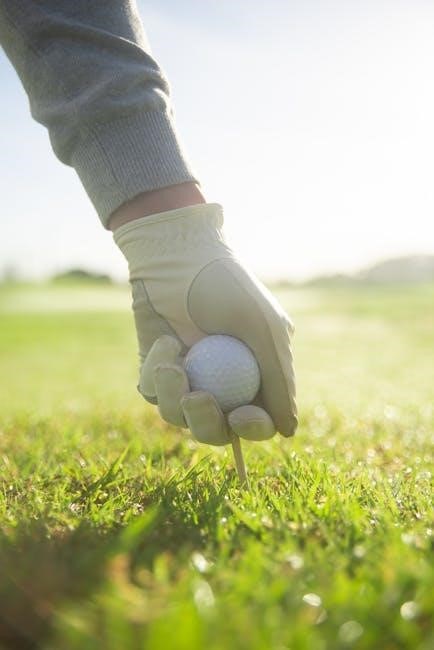Golf glove sizing is crucial for optimal performance and comfort. Proper fit ensures a secure grip‚ preventing slippage and enhancing control during your swing. Measure hand circumference and finger length accurately to select the right size‚ as ill-fitting gloves can hinder your game. Standard sizes vary by brand‚ so consulting a size chart and considering materials like Cabretta leather is essential for the best fit.
Why Proper Fit Matters in Golf Gloves
A proper fit in golf gloves is essential for maintaining control‚ preventing slippage‚ and ensuring comfort. A glove that fits well provides consistent grip and tactile feedback‚ allowing precise control over the club. It prevents hand fatigue and discomfort‚ which can distract from performance. Proper fit also aids in moisture management‚ keeping hands dry for a secure grip. Additionally‚ it supports correct wrist and palm alignment‚ crucial for proper swing mechanics‚ and enhances durability by preventing excessive wear. A well-fitting glove contributes to consistent performance and overall satisfaction in the game.
Overview of Golf Glove Size Charts
Golf glove size charts provide a standardized guide to help players determine their ideal fit. They typically include measurements for hand circumference and finger length‚ categorized into sizes for men‚ women‚ and juniors. Charts vary slightly by brand but generally range from small to extra-large. Accurate measurements ensure proper fit‚ preventing issues like restricted movement or slippage. Materials and design also influence sizing‚ with options like Cabretta leather offering a snug fit. Using a size chart helps players avoid ill-fitting gloves‚ which can hinder performance and comfort during play.

Understanding Golf Glove Size Charts
Golf glove size charts are designed to help players find their ideal fit based on hand measurements. They typically include standard size ranges for men‚ women‚ and juniors‚ ensuring proper grip and comfort. Measurements often focus on hand circumference and finger length‚ with variations across brands. Accurate sizing is key to avoiding restrictive or loose gloves‚ which can affect performance. By understanding these charts‚ players can make informed decisions for their optimal fit.
Standard Size Ranges for Men‚ Women‚ and Juniors
Golf gloves are available in standardized sizes to accommodate different hand sizes. Men’s sizes typically range from 8 to 10.5 inches‚ measured by hand circumference. Women’s sizes generally fall between 7 and 8.5 inches‚ while junior sizes are smaller‚ often around 6 to 7 inches. These measurements ensure a snug yet comfortable fit‚ allowing for proper grip and control. The sizing is based on the circumference of the hand‚ measured around the knuckles. Proper fit is essential for performance‚ so consulting a size chart is recommended for accuracy.
How Size Charts Vary by Brand
Golf glove size charts differ slightly between brands due to variations in design and materials. Some brands cater to specific hand shapes or preferences‚ leading to unique sizing. For example‚ one brand might offer a more relaxed fit‚ while another provides a snug‚ performance-oriented design. Materials like Cabretta leather may also influence sizing‚ as they naturally stretch over time. To ensure accuracy‚ it’s essential to refer to the specific brand’s size chart and consider trying gloves on if possible. Size variations across brands highlight the importance of flexibility when selecting the perfect fit.
Key Measurements for Sizing Accuracy
Accurate sizing begins with measuring hand circumference and finger length. Measure around the knuckles‚ excluding the thumb‚ for hand circumference. For finger length‚ measure from the tip of the middle finger to the first wrist crease. These measurements ensure the glove fits snugly without restricting movement. Proper fit prevents blisters and maintains dexterity. Using a tape measure or comparing to a brand’s size chart helps determine the ideal size. Ensure to account for material stretch‚ as some gloves may loosen slightly over time.
How to Measure Your Hand for a Golf Glove
Measure your hand’s circumference around the knuckles and the length from the middle finger tip to the wrist crease using a tape measure for accuracy.
Measuring Hand Circumference
To measure hand circumference‚ wrap a flexible tape measure around the widest part of your hand‚ just below the knuckles. Ensure the tape is snug but not overly tight‚ as this affects sizing accuracy. Record the measurement in inches‚ typically ranging from 7 to 10.5 inches for men and 6 to 8;5 inches for women. This measurement is essential for selecting the correct glove size‚ ensuring a comfortable and secure fit during play.
Measuring Finger Length
Measure finger length by extending your dominant hand with fingers together. Place the tape measure from the tip of your middle finger to the first crease on your wrist. This length helps determine if your fingers will fit comfortably in the glove without excess material. Proper finger length ensures dexterity and prevents restricted movement‚ crucial for maintaining control during your swing. Accurate measurement is key to selecting a glove that balances fit and functionality.
Considering Hand Dominance
Hand dominance plays a significant role in golf glove sizing. Your dominant hand‚ whether left or right‚ typically bears more grip pressure. Measure your dominant hand to ensure the glove fits snugly‚ providing stability without restriction. A well-fitting glove on your dominant hand enhances control and consistency in your swing. Neglecting hand dominance can lead to an ill-fitting glove‚ affecting performance and comfort during play.
How to Choose the Right Size
Match your measurements to size charts‚ considering grip size and material flexibility. Ensure a snug fit without restriction‚ as proper sizing enhances performance and comfort during play.
Matching Measurements to Size Charts
Once you’ve measured your hand circumference and finger length‚ compare these dimensions to the size chart provided by the manufacturer. Most charts categorize sizes from Small to Extra-Large‚ with specific inch measurements for each. Ensure the glove fits snugly but not tightly‚ as a proper fit allows for optimal grip and control. Pay attention to brand-specific variations‚ as sizing can differ slightly. Materials like leather may stretch over time‚ so consider this when selecting your size. Left-handed golfers should also verify if the glove is designed for their dominant hand.
Factors Influencing Size Selection
Several factors influence the choice of golf glove size‚ including hand dominance‚ finger length‚ and wrist circumference. Left-handed golfers may need gloves designed specifically for their dominant hand. Additionally‚ personal preference for snugness or looseness plays a role. Seasonal use and playing conditions‚ such as humidity‚ can affect fit due to material stretch. Proper alignment of the wrist and palm ensures a consistent swing‚ while dexterity in the fingers is essential for precise club control. These elements collectively guide the selection of the ideal glove size.
Importance of Grip Size
Grip size is vital for consistent performance and control in golf. A well-fitted glove ensures a firm yet comfortable grasp‚ preventing slippage during the swing. Proper grip size enhances accuracy and reduces fatigue‚ while an ill-fitting glove can lead to inconsistent shots. The material and thickness of the glove also play a role‚ with breathability and durability impacting long-term performance. A correct grip size balances comfort and control‚ allowing golfers to maintain focus and confidence throughout their game.
Common Mistakes in Golf Glove Sizing
Common mistakes include choosing gloves too tight or too loose‚ ignoring hand dominance‚ and not considering finger length‚ leading to discomfort and performance issues.
Choosing a Glove That’s Too Tight
Choosing a glove that’s too tight can restrict finger movement and blood flow‚ causing discomfort and hindering dexterity. Tight gloves may lead to blisters or cramping during play‚ affecting performance. They can also limit the natural grip‚ leading to an inconsistent swing. Additionally‚ tight gloves may cause excessive moisture buildup‚ reducing grip stability. It’s important to ensure a snug but not restrictive fit to maintain comfort and control throughout the game.
Selecting a Glove That’s Too Loose
Selecting a glove that’s too loose can compromise your grip‚ leading to inconsistent performance. A loose fit allows the club to shift during the swing‚ affecting accuracy and control. It may also cause the glove to bunch up‚ creating discomfort and distractions. Over time‚ a loose glove can lead to hand fatigue and reduced precision. Ensuring a proper fit is essential to maintain a consistent swing and overall playing comfort.
Ignoring Hand Dominance
Ignoring hand dominance when selecting a golf glove can lead to discomfort and affect performance. Each hand has a unique shape and size‚ so using a glove designed for your non-dominant hand may result in an improper fit. This can cause the glove to feel too tight or too loose‚ impacting grip consistency and control. Always measure your dominant hand to ensure the glove is tailored to its specific dimensions for optimal comfort and accuracy during play. Proper fit is key to a consistent swing.

Materials and Their Impact on Fit
Materials significantly influence golf glove fit and performance. Cabretta leather offers a soft‚ durable feel‚ while synthetic materials provide consistent fit and moisture-wicking properties‚ enhancing comfort during play.
Cabretta Leather vs. Synthetic Materials
Cabretta leather and synthetic materials differ significantly in feel and durability. Cabretta leather is renowned for its softness‚ breathability‚ and natural grip‚ making it ideal for precise control; It molds to the hand over time‚ offering a customized fit. Synthetic materials‚ while more affordable‚ provide consistent performance and are easier to clean. They are often moisture-wicking‚ which keeps hands dry during play. Both options cater to different preferences‚ ensuring a comfortable and secure fit for golfers of all levels.
Stretchiness and Flexibility
Stretchiness and flexibility are key factors in a golf glove’s comfort and performance. A glove with the right amount of stretch allows natural hand movement during your swing‚ reducing restriction.
Flexibility ensures dexterity‚ letting you maintain precise control of the club. Look for gloves with strategic stretch zones‚ especially in the back and fingers‚ to enhance mobility without compromising fit. Proper balance prevents excessive wear and ensures durability‚ keeping your glove comfortable round after round.
Moisture Management
Moisture management is vital for maintaining grip and comfort during your game. High-quality golf gloves often feature breathable materials that wick away sweat‚ ensuring your hands stay dry. This prevents slippage and keeps the glove snug‚ even during intense play. Look for gloves with moisture-wicking fabrics or perforations that enhance airflow. Proper moisture control not only improves performance but also extends the glove’s lifespan by preventing deterioration from sweat buildup. A dry glove ensures consistent grip pressure and comfort throughout your round.

Proper Fit Characteristics
A well-fitting golf glove should feel snug but not restrictive‚ allowing full finger dexterity and proper wrist alignment. It should mold to your hand like a second skin‚ providing consistent grip pressure without pressure points.
Snugness Without Restriction
A proper-fitting golf glove should feel snug but not constricting‚ allowing for natural hand movement. It should hug your palm and fingers without applying pressure‚ ensuring consistent grip pressure. A glove that’s too tight can restrict wrist motion and finger dexterity‚ while one that’s too loose may slip during the swing. The ideal fit provides a balance of support and flexibility‚ enabling precise control and feel. Materials like Cabretta leather often mold to your hand‚ offering a snug yet comfortable fit that enhances performance without sacrificing mobility.
Finger Length and Dexterity
Finger length is critical for maintaining dexterity in a golf glove. The glove should fit snugly without bunching or restricting finger movement‚ ensuring precise grip control. Proper fit allows fingers to bend naturally‚ preventing discomfort or loss of feel. Measure finger length to ensure the glove’s fingertips align correctly‚ avoiding excess material that could hinder performance. A well-fitted glove enhances tactile sensitivity‚ crucial for consistent ball striking and shot accuracy. Prioritize stretchiness and flexibility to maintain full hand mobility during the swing.
Wrist and Palm Alignment
Proper wrist and palm alignment ensures the glove sits naturally‚ supporting the hand without twisting. Measure from the base of the palm to the first wrist crease to determine length. The glove should align seamlessly with the wrist‚ avoiding bunching or pulling. Correct alignment ensures consistent grip pressure and club control. A well-fitted glove prevents excessive movement‚ maintaining stability throughout the swing. Proper fit around the palm and wrist enhances comfort and performance‚ allowing for precise ball striking and consistent results on the course. Accurate sizing is key for optimal alignment and functionality.

Troubleshooting Poor Fit
If your glove feels restrictive or too loose‚ reassess measurements and size. Adjustments may include re-measuring or trying a different size for optimal comfort and performance.
Signs of an Ill-Fitting Glove
An ill-fitting glove can cause discomfort and hinder performance. Look for signs like fingers digging into the thumb pad‚ restricted dexterity‚ or uneven wear patterns. If the glove feels too tight‚ it may restrict wrist movement‚ while a glove that’s too loose can lead to a lack of control. Pay attention to areas where the material bunches or stretches excessively‚ as these indicate improper sizing. Addressing these issues ensures a more comfortable and effective grip during your game.
Adjustments for Better Comfort
To enhance comfort‚ consider stretching your glove by wetting it and shaping it to your hand. If the glove feels too tight‚ try a larger size or opt for a stretchier material like Cabretta leather. Adjust the fit by ensuring proper wrist alignment and avoiding bunching around the palm. Ensure the grip size matches your hand to prevent strain. These small adjustments can significantly improve dexterity and overall comfort‚ allowing for a more consistent and enjoyable golfing experience.
When to Replace Your Glove
Your golf glove should be replaced when it shows signs of wear‚ such as holes‚ fraying‚ or a noticeable loss of grip. If the glove becomes stretched out or too loose‚ it can compromise your control. Additionally‚ if the material begins to break down or loses its moisture-wicking properties‚ it’s time for a new glove. For optimal performance‚ replace your glove every 1-2 months if you play frequently‚ or when you notice a decline in fit or functionality.

Brand-Specific Sizing Differences
Golf glove sizing varies across brands‚ with some offering more tailored fits while others provide a standard range. Always consult the specific brand’s size chart for accuracy.
Popular Brands and Their Sizing
Leading brands like Bionic‚ Titleist‚ and Callaway offer detailed sizing charts. Bionic uses hand circumference measurements‚ while Titleist and Callaway provide standard sizes (S-XXL). TaylorMade and Ping also offer similar ranges‚ catering to men‚ women‚ and juniors. Materials like Cabretta leather ensure durability and comfort. Always check the brand’s specific chart‚ as sizing can vary slightly. Proper fit is crucial for grip and performance‚ so comparing measurements is key to selecting the right glove.
Comparing Size Charts Across Brands
Golf glove size charts vary slightly between brands‚ with most offering similar size ranges (S-XXL) for men‚ women‚ and juniors. Brands like Titleist and Callaway use standard measurements‚ while Bionic emphasizes hand circumference. TaylorMade and Ping chart sizes differently‚ catering to diverse hand shapes. Always compare your measurements across brands‚ as slight variations exist. Proper fit ensures optimal grip and comfort‚ so consulting each brand’s chart is essential for the best results.
Custom Fit Options
Some premium brands offer custom fit options to ensure a tailored glove. Measure hand circumference‚ finger length‚ and wrist alignment precisely. Submit these measurements to the manufacturer for a glove designed to your specifications. Custom gloves provide optimal comfort and performance‚ reducing the risk of poor fit. This service is ideal for golfers with unique hand shapes or specific preferences‚ enhancing their grip and control during gameplay. Many brands provide online fitting guides to help determine the perfect custom size.
Getting the Best Fit
Getting the best fit for your golf glove involves measuring your hand accurately‚ consulting size charts‚ and considering your comfort preferences. Proper fit enhances grip control and performance.
Trying Gloves On In-Store
Trying gloves on in-store ensures a precise fit and comfort. Test the snugness‚ flexibility‚ and grip by wearing the glove as you would during a swing. Seek expert advice from staff to confirm sizing and material suitability. This hands-on approach allows you to evaluate how the glove feels and performs‚ ensuring optimal grip control and dexterity. It’s the best way to confirm your size and preferences before making a purchase‚ especially if you’re unsure about sizing or material preferences.
Buying Online: Tips and Tricks
Buying golf gloves online requires careful consideration to ensure the right fit. Always refer to the brand’s size chart and measure your hand circumference and finger length beforehand. Read reviews from other customers to gauge sizing accuracy and comfort. Look for return or exchange policies in case the fit isn’t ideal. Double-check the material and grip style to suit your preferences. While online shopping is convenient‚ ensure you’re buying from a reputable seller to avoid counterfeit products. A well-fitting glove enhances your game‚ so don’t hesitate to reach out for size guidance.
Using Reviews for Guidance
Customer reviews are invaluable when selecting a golf glove online. They provide insights into fit‚ comfort‚ and durability from real users. Look for feedback on sizing accuracy‚ as experiences can vary by brand. Pay attention to common themes‚ such as whether gloves run small or large. Reviews can also highlight specific features‚ like grip quality or moisture management. While individual preferences differ‚ reviews offer a collective perspective to help narrow down choices. Use them alongside size charts to make informed decisions for the best fit and performance.
Properly fitting golf gloves enhance performance and comfort‚ ensuring a secure grip and confidence. Use this guide to find your ideal size and elevate your game.
To ensure the best fit‚ measure your hand circumference and finger length accurately. Consult size charts‚ considering brand variations and materials like Cabretta leather. Proper fit enhances grip‚ control‚ and comfort‚ avoiding common mistakes like tight or loose gloves. Regularly replace worn gloves and try them on if possible. Use online reviews for guidance and prioritize moisture management for durability. A well-fitting glove elevates performance and confidence in your game.
Final Tips for Optimal Fit
Ensure your glove feels snug but not restrictive‚ allowing finger dexterity. Prioritize breathability and moisture-wicking materials for comfort. Regularly inspect and replace worn-out gloves to maintain grip quality. Consider custom-fit options for unique hand shapes. When shopping online‚ use detailed size charts and customer reviews for guidance. Always try gloves on if possible‚ and opt for reputable brands known for consistent sizing. A well-fitting glove enhances performance‚ control‚ and overall golfing experience.
Frequently Asked Questions
Common questions include how often to replace gloves‚ care tips‚ and sizing accuracy. Addressing these ensures optimal performance‚ comfort‚ and longevity of your golf gloves.
How Often Should I Replace My Golf Glove?
Golf gloves should be replaced every 6 to 12 months‚ depending on usage and wear. If the glove shows signs of heavy wear‚ such as fraying or loss of grip‚ replace it immediately. Moisture buildup and stretching are also indicators it’s time for a new glove. A properly fitting glove is essential for consistent performance‚ so check regularly for signs of deterioration.
Can I Use One Glove for Both Hands?
Using one golf glove for both hands is not recommended. Golf gloves are designed specifically for either the left or right hand to provide a precise fit and optimal grip. Wearing a glove on the non-dominant hand can cause discomfort and affect performance. It’s best to use a glove tailored to your dominant hand to maintain control and consistency during your swing.
How Do I Care for My Golf Glove?
To maintain your golf glove’s quality‚ gently clean it with mild soap and lukewarm water. Avoid machine washing‚ as it may damage the material. Air dry the glove away from direct sunlight to prevent cracking. Store it in a cool‚ dry place when not in use. Regular cleaning and proper storage will extend its lifespan and ensure consistent performance on the course.